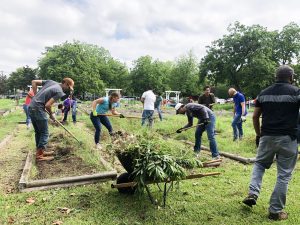Welcome to Kashmere Gardens
Sitting just above our original service zip code, 77020, lies this week’s focus: 77026. Nestled in the northern 610 Loop between an industrial area and a rail corridor, the zip code is split between the Greater Fifth Ward neighborhood and Kashmere Gardens neighborhood.

A map of the zip codes we serve and the client populations in those areas.
Driving through Kashmere Gardens, one will quickly notice the large lot sizes with single-family homes. Houston Gardens, completed in 1937, was part of the Suburban Resettlement Administration program created during the New Deal. The point of the program was to relocate struggling urban and rural families to new subsistence communities planned by the federal government. Established to be self-sufficient communities, the large plot sizes encouraged small-scale farms for community growth, as well as community centers and schools.
Like Greater Fifth Ward, Kashmere Gardens has a history of social activism – namely in leading the fight for school integration in Houston. Tyrone Day was the first Black student to enroll at an all-white elementary school in Houston. He enrolled at Kashmere Gardens Elementary in 1960, one of 12 students accepted into H.I.S.D. to begin school integration. Students at Kashmere High School were also involved in integration efforts, boycotting the ongoing segregation in Houston’s schools in 1965, more than 10 years after the Brown v. Board of Education decision in 1954. H.I.S.D. desegregated in 1984.
Frenchtown in Houston
Greater Fifth Ward’s Frenchtown takes up the southern section of 77026. Frenchtown, briefly mentioned in our history of 77020, is a four-square block community. Established in 1922, it primarily consisted of Creoles of French, Spanish, and African descent from Louisiana, lending it the name it still carries. Houston was finding great success at this time, and many workers were attracted to the city, leading to the settling of Frenchtown. Workers were interested in the Southern Pacific Railroad, oil industries, and opportunities along Houston’s Ship Channel. Additional immigration waves occurred following the Mississippi River Flood of 1927 and Houston’s growth during World War II.
The Area Today

Volunteers working at our Willie H. & Gladys R. Goffney Community Garden in Kashmere Gardens.
As with 77020, the area saw great change following World War II and desegregation. Middle-class residents seeking opportunities elsewhere began moving to the suburbs. The area currently has 23,249 residents, nearly 50% of which are black or African American. The area has seen a surge in its Hispanic residents, increasing from 19% in 1990 to 31% in 2000, and now 48%. 1,561 families, out of the community’s 5,266, live below the poverty line. The median household income is $31,184, half of Harris County’s median of $63,699. Kashmere Gardens experienced great damage during Harvey, seeing some of the first flooding in the city and the eventual official closing of their library from damage.
The area has a special place for Target Hunger because it is home to our Willie H. & Gladys R. Goffney Community Garden that has been tended to since our founding in 1989. We are grateful to have a spot in the community that not only provides fresh produce for the people we serve, but also provides a beautiful green space.It is beloved by community members, volunteers, and staff alike. We encourage you to visit the garden by volunteering one day, and while you’re there, tour the Kashmere Gardens neighborhood.
References:
https://en.wikipedia.org/wiki/Kashmere_Gardens,_Houston
https://www.houstoncc.org/our_communities/kashmere_gardens/index.php




